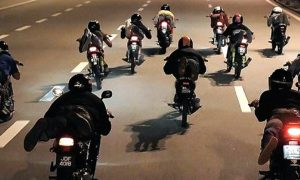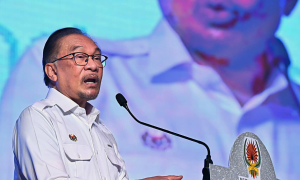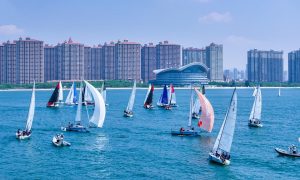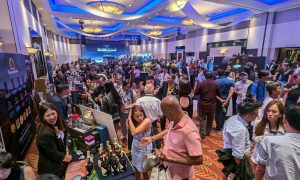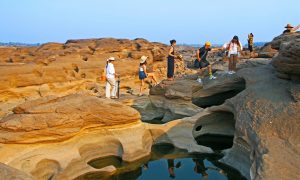One of my favourite books of all time is One Crowded Hour by Tim Bowden, Harper Collins 1994. While the author isn’t a relative the book is a wonderful account of the life and times of the late Australian combat cameraman Neil Davis. His footage was how many of us who were alive during the Vietnam War kept in touch with the horrors of this tragedy and his life was celebrated in the David Bradbury movie Frontline. Davis’ most poignant footage was of North Vietnamese tank number 843 storming the South Vietnamese Independence Palace on April 30, 1975. Being the astute combat cameraman that he was, Davis knew this was the picture that would signify the end of the conflict and he was the only television cameraman there to capture what was to be shown around the globe.
This image is etched in my brain and flashes back every time I travel to Ho Chi Minh City (HCMC). Needless to say, HCMC is a vastly different city to the one that Davis captured on film in 1975. Vietnam has changed rapidly and the American War (as the Vietnamese call the Vietnam War) is well and truly behind them as the developing economy forges into the 21st century. The country is very much a tale of two cities with Hanoi being the political base and HCMC (or Saigon as many still refer to it) being the rapidly developing economic hub.
Southern Star
Located inland on the Saigon River, Vietnam’s biggest city (over six million) and financial and economic centre is closer to Kuala Lumpur than you think. Being just 90-minutes from the Malaysian capital on Malaysia Airlines’ new 737-800 aircraft, you hardly have time to acclimatise to the aircraft’s plush new interior.
While the skyscrapers rise above tree-lined boulevards there are still many elements of old Saigon that make the city such a great tourist destination. In pockets of the city old men wearing berets ride their bicycles along the street with a baguette under their arm. You have to look closely at the Asian faces to remind yourself that you are indeed in Vietnam and not France.
Evidence of French colonialism remains today to give the city’s architecture its eclectic characteristics. Modern day mirrored glass and aluminium are the façades of choice these days as the city slowly falls in line with many other modern and somewhat featureless Asian cities.
Vietnam in general appeals for the value it presents travellers as food and drinks are cheaper than in Malaysia and various accommodation options are available from the backpacker/flashpackers quarters of Pham Ngu Lao to the smart international hotels located mostly in District One.
War, What is it good for?
The only troops visitors will see in HCMC these days are the troops of motorcyclists who move along the streets like squadrons of MiG fighters seeking out lackadaisical pedestrians nervously crossing the streets. While this is an issue today, one wonders what it will be like when all the cyclists give up their bikes for a modern motorcycle within the next decade. Then the concern for the decade after is when the motorcyclists graduate to cars. See HCMC before it becomes a carpark!
Following the advice of every guidebook ever written on Vietnam, I assertively head into the traffic and keep moving gently forward. Miraculously, the sea of bikes moved around me and I lived to relate the tale.
Vietnam War buffs need to drop by the War Remnants Museum to look at all the war paraphernalia amassed here. Its previous name, the House for Displaying War Crimes of American Imperialism, is reason enough to visit. American fighting machines such as an F-5A fighter jet, a “Huey” helicopter, daisy cutter bombs and an M48 Patton tank are to be found here. There’s also a guillotine from the French colonial era.
Civic Pride
A good way to take in the city is from park in front of the Hotel de Ville or Town Hall. It dates back to 1898 when work started on what was the town hall featuring French colonial architecture and based upon the town hall in Paris. The bell tower on top is a feature and while visitors aren’t allowed inside what is now the Office of the HCMC People’s Committee, it’s a building that’s well worth admiring from afar. Take the elevator to the Rooftop Bar on top of the adjoining Rex Hotel, with its huge golden crown fixture and elephant statues. The bar really hasn’t changed much and it’s still as atmospheric as ever especially at dusk and in the evening. From here there’s a great view of the Hotel de Ville, the park featuring a statue of Uncle Ho, Parkson Mall, Hotel Continental and the Opera House which all surround the park on Nguyen Hue Boulevard.
Fanciful Food
To visit HCMC and not try a bowl of pho (‘fur’) is like visiting Malaysia and not eating nasi lemak. Pho is served mostly with chicken or beef and it’s available all over the city from makeshift kerbside stalls to designer versions in international hotels. A local chain called Pho 24 maybe the best place to start for those who aren’t prepared to dine on the streets. The beef pho at Pho Quynh (323 Pham Ngu Lao St) is famous and a steal at just a few Ringgit.
Some other highly recommended restaurants to seek out in HCMC include Cepage (22 Le Thanh Ton St), Tib Restaurant (187 Hai Ba Tung St) and River Café (53 Vo Truong Toan St). Coffee is taken seriously in HCMC with several local concept stores. Coffee in most shops is served in aluminum immersers that are placed over a small cup for the water to filter over the beans. Enjoy local coffee in concept stores such as Highlands Coffee, Trung Nguyen and My Life Coffee.
Sunset Saigon
Like most Asian cities, HCMC takes on a different persona as the sun sets. There are several bar streets and districts with one of the most central being Ton That Thiep St. Beer is the beverage of choice for most with 333 being the most popular local beer although Halida and Saigon are also available. Fresh beer hoi is sold on the streets for ridiculously cheap prices but its taste may not have universal appeal.
Gartenstadt (16-18 Nguyen Hue St) serves German beer on tap and there are many more by the bottle at prices well below what you would pay in KL. Try Schneider Weisse by the bottle. Bier Garden (125 Dong Khoi St) is similar in concept but more open to the street.
Famous bars like Apocalypse Now still maintain their appeal to those who have been visiting Vietnam for a long time. The new found wealth of younger Vietnamese has seen the rapid growth of designer bars round the city. Level 23 on top of the Sheraton Hotel is one of the city’s coolest bars. Patrons enjoy 360o city views and dancing girls who like their designer cocktails. Saigon Saigon is a rooftop bar in the Caravelle Hotel, ten floors above the busy area around the Opera House. This was one of Neil Davis’ favourite haunts when it was the war correspondents’ bar during the Vietnam War.
Souvenir Shopping
Ben Thanh Market in downtown HCMC is the place to start looking for many shopping bargains. There’s a map of all the stalls just inside the main entrance but entering and wandering is highly recommended. Seek out colourful revolutionary-styled posters where reproductions are inexpensive but original works are expensive. Check out the designer interiors and fashion items at Mai Lâm besides the Continental Hotel. For well-known international designer labels head to the Rex Hotel (Cartier, Ralph Lauren and Bvlgari among others) or along Dong Khoi Street in District One.
Interior décor items are also well-priced with shops like Mantra (84 Pho Duc Chinh St) and Catherine Denoual Maison Boutique (15C Thi Sach St) being two places to start searching. For something old, head to Antique Street (Le Cong Kieu St) has about 50 small shops packed with items ranging from trash to treasure. Check out the vintage cameras in a place here called Quoc Tuan (26 Le Cong Kieu St). Old watches are something to look out for but if you think you’ll pick up an antique Patek Philippe for a steal; dream on.
Getting there and around
Malaysia Airlines (www. malaysiaairlines.com) mostly flies to HCMC with its new Boeing 737-800 aircraft. Full leather seating and in-seat entertainment with movies and music to ensure that you enjoy the flight better. Getting around is easy with the downtown area or District One being best done on foot. Taxis are the alternative and they should use the meter.
Where to stay
The Windsor Plaza Hotel (www.windsorplazahotel.com) is one of the city’s leading hotels located just out of the city centre.
This article was written by David Bowden
Source: The Expat November 2011
This article has been edited for ExpatGomalaysia.com
Get your free subscription and free delivery of The Expat Magazine.
"ExpatGo welcomes and encourages comments, input, and divergent opinions. However, we kindly request that you use suitable language in your comments, and refrain from any sort of personal attack, hate speech, or disparaging rhetoric. Comments not in line with this are subject to removal from the site. "






